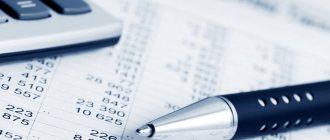- Accounting for the organization's income
- Accounting for organization expenses
- Formation of financial results for ordinary activities of the organization
- Formation of financial results for other income and expenses
- Formation of the final financial result (net profit or loss)
At enterprises, the following main indicators are taken into account, planned and analyzed:
- expenses for ordinary activities (produced by the organization) in an element-by-element context;
- cost of sales of products in two versions: a) production; b) total as the sum of production costs and period expenses (general and commercial);
- costs (cost price) per 1 rub. products in two versions: production and complete;
- calculation of the cost of individual products as a basis for setting prices taking into account supply and demand.
The cost of production performs the function of accounting and control over the level of costs for the production and sale of products; serves as the basis for setting prices for the enterprise’s products and determining profit and profitability on this basis; acts as an economic justification for any management and investment decisions of the enterprise; reflects the efficiency of resource use, the results of introducing new equipment and technology, improving the system of organization and production management.
The cost of production can be calculated using economically homogeneous cost elements and costing items. The ratio of individual economic elements in total costs determines the structure of costs for the production and sale of products.
Grouping costs by economic elements shows the material and labor costs of an enterprise without distributing them to individual types of products and other economic needs and is used to coordinate the cost plan with other sections of planning.
Grouping costs by expense items (costing items) makes it possible to see costs by their place and purpose, and also to know how much it costs the company to produce and sell certain types of products. This is necessary in order to determine under the influence of what factors the cost level was formed and in what directions it is necessary to fight to reduce it.
Depending on the tasks of managing expenses (costs) and cost in planning (budgeting), accounting and analysis, classifications of costs are used according to various criteria
For financial accounting, a classification of costs is used according to the period of their write-off in relation to sales: here they determine the cost of products sold for the period and expenses for the full period, which may not be related to the sale of a given period, but are contained in the balances of work in progress, in goods remaining for end of the period in the warehouses of the enterprise.
Management accounting uses all possible classification criteria to make management decisions related to different classification criteria. Thus, to calculate the cost of individual products, a classification of expenses is used into direct and indirect, to justify break-even sales - into variable and fixed, etc.
Main elements of expenses for ordinary activities
Pay attention to the table of expenses for ordinary activities.
| What does the organization do? | What expenses are considered for ordinary activities? |
| Providing for a fee for temporary use (temporary possession and use) of one’s assets under a lease agreement | The implementation of which is related to this activity |
| Providing for a fee rights arising from patents for inventions, industrial designs and other types of intellectual property | |
| Participation in the authorized capital of other organizations |
If the expenses listed in the table are not the subject of the organization’s activities, then they are classified as other expenses.
Also see “What Other Expenses Include in Accounting.”
Also for ordinary activities there are expenses in the form of reimbursement of the cost of fixed assets, intangible assets and other depreciable assets, in the form of depreciation charges.
INCREASING THE ROLE OF INTERNATIONAL STANDARDS IN RUSSIAN ACCOUNTING.
Since 06.08.2017, a new edition[2] of PBU 1/2008 “Accounting Policy” has been in effect. According to clause 7.1 of PBU 1/2008, if for a specific issue of accounting the federal accounting standards do not establish accounting methods, the enterprise develops an appropriate method based on the requirements established by the legislation of the Russian Federation on accounting, federal and (or ) industry standards. In this case, the company uses the following documents sequentially:
- international financial reporting standards;
- provisions of federal and (or) industry accounting standards on similar and (or) related issues;
- recommendations in the field of accounting.
Let us recall that in the previous edition of PBU 1/2008, IFRS also acted as a source for the formation of an enterprise’s accounting policy on a specific issue, but did not have the primacy that is given to them now.
The Ministry of Finance does not limit enterprises to the above-mentioned rights and allows deviations from the rules in exceptional cases when adherence to the requirements of international and Russian standards may lead to an unreliable representation of the financial position of the enterprise, the financial results of its activities and the flow of its funds in the accounting (financial) statements. The conditions for deviation from the current rules are listed in clause 7.3 of PBU 1/2008.
And finally, in the case of immaterial information (that is, when the economic decisions of users of these statements do not depend on its presence, absence, or method of reflection in the financial statements of an enterprise), the enterprise has the right to be guided solely by the requirement of rationality. The enterprise classifies information as non-essential independently based on both the size and nature of this information.
What approaches of international standards can enterprises adopt when solving the problem of matching expenses with income? Let us turn to the rules for reflecting expenses in financial statements.
Accounting for expenses for ordinary activities
The expenses in question are accepted for accounting in a monetary amount equal to the payment:
- in cash and other forms;
- the amount of accounts payable (taking into account clause 3 of PBU 10/99).
If payment covers only part of the recognized expenses, then the expenses taken into account are the sum of payment and accounts payable (in the part not covered by payment).
The amount of payment and/or accounts payable is determined based on the price and conditions established by the agreement between the organization and the supplier (contractor) or other counterparty.
If the price is not provided for in the contract and cannot be established based on its terms, to determine the amount of payment or accounts payable, the price at which, in comparable circumstances, the organization usually determines expenses in relation to:
- similar inventories and other valuables, works, services;
- provision of temporary use (temporary possession and use) of similar assets.
When paying for purchased materials and other valuables, works, services on the terms of a commercial loan in the form of deferred/installment payment, expenses are taken into account in the full amount of accounts payable.
Also see “Accounting for inventories”.
The amount of payment and/or accounts payable under contracts providing for the fulfillment of obligations (payment) not in money is determined by the cost of goods (valuables) transferred or to be transferred by the organization - based on the price at which, in comparable circumstances, the company usually determines the cost of similar goods (valuables) .
If it is impossible to establish the cost of goods (valuables) transferred or to be transferred by the organization, the amount of payment and/or accounts payable under agreements providing for non-monetary settlement is determined by the cost of products (goods) received by the organization - based on the price at which a similar product is purchased in comparable circumstances products (goods).
Peculiarities:
- in the event of a change in the obligation under the contract, the initial amount of payment and/or accounts payable is adjusted based on the value of the asset to be disposed of - based on the price at which, in comparable circumstances, the organization usually determines the value of similar assets;
- the amount of payment and/or accounts payable is determined taking into account all discounts (discounts) provided to the organization in accordance with the agreement.
Also see “What is the statute of limitations for accounts payable.”
Return on sales
Profitability of sales depends on sales prices, sales volume and the share of costs in the total volume of products sold. Shows what portion of an organization's revenue is profit.
Profit, in turn, depends on how much sales revenue covers the costs incurred. In other words, the higher the revenue and the lower the costs, the higher the profit, and therefore the more efficient the business activity.
Revenue can increase due to an increase in sales volume or an increase in prices for products, goods, works, services. Costs can be reduced through the effective use of inventory and materials (compliance with cost standards, reduction of waste and defects), optimization of costs for maintaining administrative personnel, etc.
Example 2
The manufacturing company produces three types of products.
The values of financial performance indicators are in table. 2.
Let's analyze the profitability of sales.
They are presented in table. 2 data shows that the most profitable in terms of sales are goods A and C - the marginal return on sales was 41% (provided by low variable costs).
Next comes product B, whose marginal return on sales is 39.10%.
The overall return on sales in terms of marginal profit is 40.27%, in terms of operating profit - 6.04%. This difference between marginal and operating profitability is explained by the high share of fixed costs for personnel and advertising.
The total share of costs in revenue is 94%. This is a lot, so the company did not make much profit from sales. Operating profit amounted to RUB 410,000. With sales income of 8 million rubles. Such a profit can be called modest, but it covered all the company's costs.
The profitability of sales by type of product is presented in Fig. 3.
Break even
The company may not make a profit, but also not incur losses. This “golden mean” is reflected by the break-even point (critical point).
The critical point shows how far revenue can fall before there is a loss. The equality of income and expenses in this case can be written by the following equation:
VRKT = Zper + Zpost
or:
Sales volume × Sales price per unit of product (work, services) = Sales volume × Sales/unit. + Zpost.
The minimum (critical) sales volume can be calculated using marginal profit - as the sales volume at which marginal profit is equal to fixed costs:
Pmarzh = BP – Zper = Zpost.
We find the critical point of sales volume, i.e. we determine how many units of product need to be sold in order not to make a loss:
Critical point (in units of sales) = Zpost / Pmargin = Zpost / (Price per unit – Zper./unit).
This calculation can be made for the entire range and for individual types of products.
Example 3
A manufacturing company produces plastic products. Quantitative accounting of sales volume is carried out in pieces.
According to the plan, the production of products is 15,000 pieces, the selling price is for 1 piece. — 400 rub.
Let's determine how many plastic products need to be sold so that the income from the sale covers all expenses, i.e., we determine the break-even point.
The production and sales plan is presented in table. 3.
Critical point = 876,000 rub. / (400 rub. – 208 rub.) = 5104 pcs.
Conclusion
The company needs to produce 5,104 plastic products to cover all costs. If sales volume is lower, the company will make a loss.
Using the relationship between fixed costs and marginal profit per unit of production, you can find out whether fixed costs are recoverable and obtain information about the amount of marginal profit for each type of product.
By changing the amount of fixed costs or sales price, you can plan the minimum volume of production.
Example 4
Let's use the initial data of example 3.
The company's management decided to reduce general expenses by 10% and increase the sales price by 5%.
Then fixed costs will be equal to:
980,000 rub. – 10% = 882,000 rub.,
and sales price for 1 piece:
400 rub. + 5% = 420 rub.
Let us determine the minimum sales volume (critical) point in this case.
The adjusted production and sales plan is presented in table. 4.
Sales critical point:
882,000 rub. / (420 rub. – 208 rub.) = 4160 pcs.
Before optimization, the critical sales volume was 5104 units. And now the company needs to produce only 4160 units. products so as not to be at a loss.
Conclusion
With such optimization of costs and sales price growth:
- the planned profit will increase by 398,000 rubles. (RUB 2,298,000 – RUB 1,900,000), the growth rate will be 17.32% (RUB 2,298,000 – RUB 1,900,000) / RUB 2,298,000 × 100%));
- sales volume at the break-even point decreased by 944 units. (5104 pcs. – 4160 pcs.), or by 18.5% ((5104 pcs. – 4160 pcs.) / 5104 pcs. × 100%).
Analysis of the ratio of income and expenses in production plans allows you to calculate the required amount of profit. In this case, the following relationship is used:
BP = Zper + Zpost + Profit (target value).
The volume of sales in quantitative terms (in natural units - kg, m, pcs., etc.), which will ensure the target profit, can be calculated using the formula:
Vsales, units = Zpost + Profit (target) / (Price of 1 unit – Zper./unit).
If we put the value of marginal profit into the formula, the formula will look like:
Vsales, units = (Zpost + Profit (target)) / Pmargin/unit.
Example 5
The company has set the planned profit from sales at RUB 100,000.
The selling price of 1 product is 400 rubles.
Fixed costs for the period are 980,000 rubles, and variable costs per unit of product are 208 rubles.
Let's calculate how many products need to be sold to get the planned profit:
1. Find the marginal profit for 1 product:
400 rub. – 208 rub. = 192 rub.
2. Determine the required sales volume in units
(980,000 rub. + 100,000 rub.) / 192 rub. = 5625 pcs.
Conclusion
To make a profit of 100,000 rubles, the company must sell 5,625 products.
Example 6
Data for calculation:
income from sales - 6,000,000 rubles;
price of 1 product - 400 rubles;
variable costs per 1 piece. — 208 rub.;
fixed costs for the period - 980,000 rubles;
marginal profit per unit - 192 rubles. (400 rub. – 208 rub.).
Let's calculate the ratio of gross profit to revenue and determine the profit from sales:
1. Find the percentage ratio of the marginal profit per unit of product and its selling price:
192 rub. / 400 rub. × 100% = 48%.
2. Determine the total gross profit:
6,000,000 rub. × 48% = 2,880,000 rub.
3. Determine the profit from sales - subtract the amount of fixed expenses from the total gross profit and get the company's operating profit:
RUB 2,880,000 – 980,000 rub. = 1,900,000 rub.
Rules for grouping expenses by ordinary activities
Further formation of expenses for ordinary activities goes towards:
- expenses associated with the acquisition of raw materials, materials, goods and other materials;
- expenses arising directly in the process of processing (refinement) of inventories for the purposes of producing products/performing work/providing services and their sale, as well as the sale (resale) of goods (costs of maintaining and operating fixed assets and other non-current assets, as well as maintaining them in in good condition, commercial expenses, administrative expenses, etc.).
When generating expenses for ordinary activities, it is necessary to group them into the following elements:
- material costs;
- labor costs;
- contributions for social needs;
- depreciation;
- other costs.
For management purposes, accounting organizes the accounting of expenses by cost items. The organization establishes their list independently.
Subsequent analysis of expenses for ordinary activities
To form a financial result from ordinary activities, the cost of goods, products, works, and services sold is determined. It is formed on the basis of:
- expenses for ordinary activities recognized in the reporting year and in previous reporting periods;
- carryover expenses related to the receipt of income in subsequent reporting periods;
- adjustments depending on the characteristics of production and sales.
At the same time, selling and administrative expenses can be recognized in the cost of goods sold in full in the reporting year and recognized as expenses for ordinary activities.
The rules for accounting for the costs of production/sale of goods/performance of work/provision of services in the context of elements and items, cost calculations are established by separate regulations and Methodological Guidelines for Accounting (for example, if the MPZ is the order of the Ministry of Finance dated December 28, 2001 No. 119n).
Also see “How expenses are recognized in accounting.”
Read also
17.09.2019
Line numbering
In the standard Report form, the lines are not numbered. The codes for the lines can be found in Appendix 4 to the order of the Ministry of Finance of Russia dated July 2, 2010 No. 66n. You only need to number the lines if you submit reports to the statistics department and the tax office. However, there are specific features for certain categories of organizations. For example, small businesses reflect aggregated indicators in their balance sheets, which include several indicators. In this case, enter the line code according to the indicator that is larger in value than others included in this line.
If you prepare reports for shareholders or other users who are not representatives of state control, it is not necessary to number the lines.
This follows from paragraph 5 of the order of the Ministry of Finance of Russia dated July 2, 2010 No. 66n.





